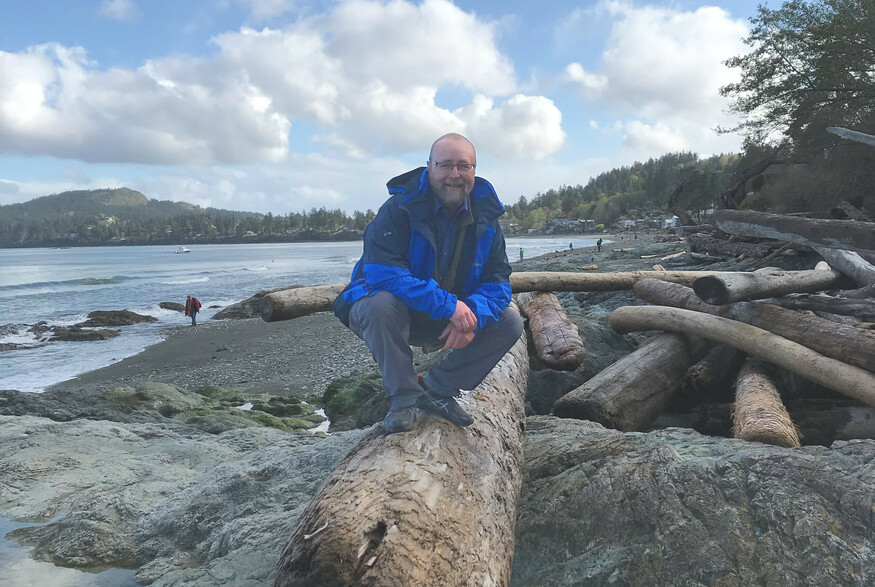
As Tracy Scott retires from Ducks Unlimited Canada (DUC) – and the NSWA board – we wanted to ask him about his inspiring work and career. We sat down with Scott to hear more about how he got involved with DUC, what he learned along the way, and how his role evolved over time.
EARLY DAYS ON THE FARM & INTO THE FIELD
Tracy Scott was born, raised on a farm north of Camrose. From early in life, Scott says he was fortunate to have a Dad who fostered his passion for the outdoors and recalls the two of them hiking around on the farm, building campfires, and hunting snowshoe hares.
After high school, Scott studied agronomy and worked as an agrologist. A friend suggested that banking might be a more lucrative career, but Scott lasted just 10 weeks in that role. Instead, he became an Agricultural (Ag) Fieldman with the County of Paintearth.
After some time as an Ag Fieldman, the local area manager for Ducks Unlimited Canada (DUC) called him and said, “We're starting this new upland cover program and we're looking for people who know how to grow forage and how to talk to farmers.” Scott expressed his interest and was hired by Ducks Unlimited in the fall of 1990.

MEMORABLE COLLEAGUES AND MENTORS
Asked about early influences and mentors, Scott says it’s hard to name all the people he learned from because there were many. He names former Area Manager/Agrologist Roger Bryan as someone who really influenced him and describes him as “friendly and a gentleman”. He also names longtime friend, mentor, and colleague, Michael Barr.
Another colleague from the Red Deer Office named Kim Schmitt gave him some wise advice: “Tracy, you need to remember a couple of things. One, we're not in the natural resource management business. We're in the people management business. And you need to understand people and what motivates them if you plan to be successful in conservation.”
CAREER PATHS
As focus and direction evolved with DUC, so did Scott. He says, “One of the things that's kept me here is that I've had the opportunity to have multiple careers with the same company.” His first half of his career he delivered on the ground programs with landowners. Then, Scott worked as the provincial watershed coordinator for about seven years. He says, “That was the heyday for me – working with WPACs [Watershed Planning and Advisory Councils] shortly after Water for Life started.” He notes that the NSWA was already formed and adds, “I was blessed to be part of getting the Battle River Watershed Alliance started as well.”
Then, after the provincial head of industry and government relations (IGR) position remained vacant for a year, DUC provincial manager, Perry McCormick, pulled Scott into his office. “Well, Tracy do you want to be the new head of IGR?” Scott agreed and began what is still his current position.
"We're not in the natural resource management business. We're in the people management business. And you need to understand people and what motivates them if you plan to be successful in conservation.”
~ advice given to Tracy Scott by Kim Schmitt
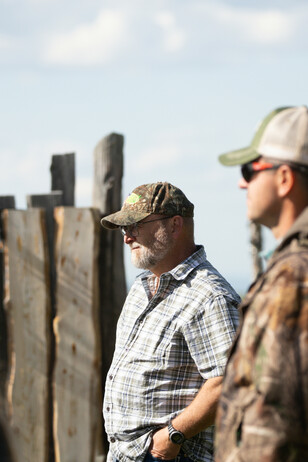
WORKING WITH FARMERS
Of working with farmers, Scott says, “I have a soft spot in my heart because I'm a farm kid, right? So, I'd like to believe that enabled me to truly understand, respect and appreciate what farmers do.”
Scott says he learned from his years of working with farmers that “farmers are, at the end of the day just regular people, and they have a living to make. They have a family to feed. And, they steward our land.” Scott adds that he tried to maintain a client-based approach throughout his career knowing that, ultimately, it’s farmers who manage what is important to DUC. “If you don't understand, respect, and meet the needs of farmers, you're not going to get very far.”
Scott always tried to respect farmers as stewards of the land and saw the DUC programs as helping the farmer’s bottom line while achieving what was important to DUC. But Scott also acknowledges that as farms become bigger and the bottom line is increasingly risky, it can make conservation work more difficult because some farmers “don't necessarily have time to maintain that intimate connection with their land like they used to because it is different model.”

COLLABORATING WITH WPACs
For seven years of Scott’s career, he worked alongside Watershed Planning and Advisory Councils (WPACs) as the provincial watershed coordinator. Having served on several WPAC boards and committees - with the Battle River (BRWA), Red Deer River (RDRWA), and the Bow River (BRBC) - he has also served as an NSWA board member for 14 years. He says, “What I appreciate about WPACs first and foremost is the collaborative nature of how WPACs work. I think it's a fantastic model.”
To illustrate the value of collaboration, Scott cites friend and mentor Michael Barr. “One of the things I learned from Mike is there's an old ancient African proverb that says, “If you want to go fast, go alone; but if you want to go far, go together.’”
Barr echoes Scott’s own ability to be a true collaborator. “Whereas most staff are DUC-centric in their thinking, Tracy recognized the importance of leveraging DUC's efforts by working in close partnership with other organizations,” says Barr. He adds, “Thanks to Tracy's great interpersonal skills and fun-loving character, DUC Alberta earned a prominent and esteemed reputation among colleagues and partner organizations alike.”
Whereas most staff are DUC-centric in their thinking, Tracy recognized the importance of leveraging DUC's efforts by working in close partnership with other organizations
~ former DUC colleague and friend, Michael Barr
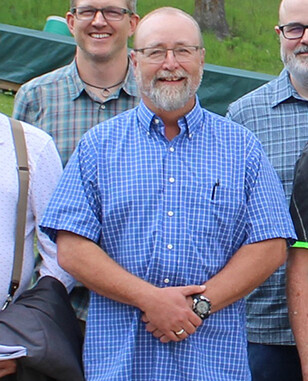
Scott recalls how in the early days of Water for Life and the role of WPACs, a lot of people were clamouring around the table over the WPACs' lack of regulatory authority. They’d say, “If we're going to achieve anything, we need authority.” Scott didn't think this was necessary. “I always maintain the strength of the WPACs is the members around the table.” Scott cites how WPACs bring together planners, scientists, rural municipalities, industry, First Nations, landowners and on-the-ground implementers like DUC to, ultimately, improve the health and function of the watershed. He thinks the many voices and parts that are doing the work are to be celebrated because they strengthen the whole.
Scott uses DUC as an example of one of the many partners at the table, saying “I've always tried to frame DUC as first and foremost an implementer.” He explains how DUC staff provide input into WPAC initiatives such as NSWA’s wetland strategy, but ultimately DUC is out in the field (along with other partners) implementing on the ground projects with rural landowners.
“Our programs provide substantial financial incentives to farmers and ranchers for provision of ecosystem services (ES), which, in turn, measurably improve the health and function of the watershed.”

CAREER HIGHLIGHTS
Looking back over the past three and a half decades, two career highlights stand out for Scott. Following the 2013 floods, Andre Corbould was leading the Watershed Resiliency and Restoration Program (WRRP) program in its early days. There were a series of public engagement sessions held by GOA to discuss how to prevent future flooding events. After several meetings, Scott was talking with Corbould over the coffee break and said, “What's your thinking around natural infrastructure?” Corbould said, “I haven't really thought about it. Do you have any suggestions?”
One thing led to another and Corbould asked Scott to present a business case for natural infrastructure projects for flood mitigation. Scott partnered with longtime friend, Terra Simieritsch, to develop a document that demonstrated the value of wetland restoration for flood mitigation. Simieritsch was able “to quantify the cost per cubic meter of storage in restored wetlands versus the cost per cubic meter for built infrastructure”. Not only did the results favour wetlands, but factoring in the other co-benefits of wetlands (biodiversity, groundwater recharge, etc.) and the lack of ongoing maintenance costs, resulted in wetland restoration emerging as a clear winner in terms of ROI.
“It was the first natural infrastructure project in the WRRP program,” Scott says. DUC secured approximately $12.5 million dollars to pay landowners in the Calgary area for a substantial amount of wetland restoration. Scott says the project was “fantastic” and is one of his most proud career moments. In his words “I felt like I was able to connect the dots in a meaningful way.”
The other highlight was the Alberta wetland policy. The initial efforts to develop a new provincial policy in 2008 failed to come to fruition due to opposition by some members at the table. It took until the fall of 2013 to achieve consensus and Cabinet approval of the policy we have today. Scott says, “I represented DUC in those years when the province convened a new advisory group to guide policy development. My approach was, and continues to be: principled, pragmatic, collaborative, and outcomes-based, and that’s how I approached what were often very difficult conversations. As a result of that process, Alberta now has a world-class provincial wetland policy that we should all be proud of. That was definitely the biggest highlight of my career.”
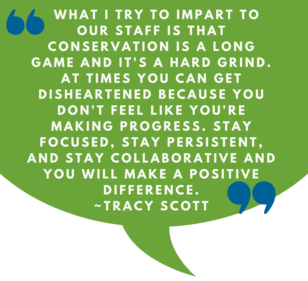
CHANGING TIMES & TRENDS
Things have changed over time in the agricultural sectors and Scott notes how “differing market signals and with commodities the way they've been, we're seeing a lot of pressure to convert native pasture into annual crop.” Scott understands the pressure, but adds that the crop sector is, due to the nature of their business, “motivated by different things. Keeping grass and keeping wetlands is not perceived to be beneficial to them.”
Scott says, “We're fortunate to still have a fair bit of native grassland in Alberta.” But he says that population expansion and demand for land conversion means we are losing our remaining native grassland at an alarming rate. “Once it’s gone it’s gone. At the end of the day, more and more people consuming more and more things makes conservation challenging.”
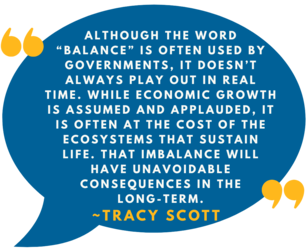
FINDING HOPE IN A CHANGING WORLD
Scott points to places he sees and finds hope in the conservation world and points to Indigenous input and world views. “I'm so happy to have Elder Leo on the NSWA board because he brings a totally different context to our meetings. He reminds us what it means to have a stewardship ethic.”
One of Scott’s early influences was Aldo Leopold’s Sand County Almanac, so a stewardship ethic is something Scott sees as critical going forward. "Unfortunately, although the word “balance” is often used by governments, it doesn’t always play out in real time. While economic growth is assumed and applauded, it is often at the cost of the ecosystems that sustain life. That imbalance will have unavoidable consequences in the long-term."
Another hopeful change Scott has witnessed is in the demographic at DUC. He says that when he started, DUC “was kind of the stereotypical old boys’ club”. His Camrose office now has four young women who are the face of DUC with landowners. Acknowledging that he sounds like a father, he says, “I'm so proud of these individuals. They’re rock stars and they've changed for the better who we are and how we're perceived.” The message they convey is “We're partners, we respect you. Let's work together.’ “
As Scott mentors these up-and-comers, he knows they will take from his experience and move things forward. When asked what advice he gives to his younger colleagues, Scott says, ”What I try to impart to our staff is that conservation is a long game and it's a hard grind. At times you can get disheartened because you don't feel like you're making progress. Stay focused, stay persistent, and stay collaborative and you will make a positive difference .”
A lifelong passion for conservation and making a difference were fulfilled in Scott’s time at DUC. “Through my career, and as luck would have it, I kind of stumbled into it through a side door.” He adds, “I'm very happy that I chose the career path I did because I'd like to believe I made a difference through my efforts.”
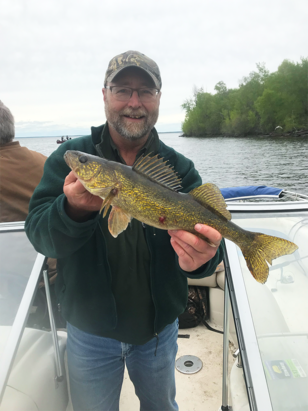
RETIREMENT PLANS: RAISING HAY & TUKTOYAKTUK
In his retirement, Scott will be “playing a small-scale farmer”, raising hay, and tending to some cows. This summer, he’ll throw his brand-new canoe on top of his truck and drive to Tuktoyaktuk for a month-long solo adventure. Then, he’s getting married in August. He says he’s too young and ambitious to sit around for long, but he needs to catch his breath and regroup. We wish him every success as he takes his own advice: “Play the long game and accept your little wins along the way.”
To learn more about Ducks Unlimited Canada, go to: www.ducks.ca
Click here to view Scott's 2022 presentation for NSWA about "Wetland Values and DUC Wetland Restoration Programs"